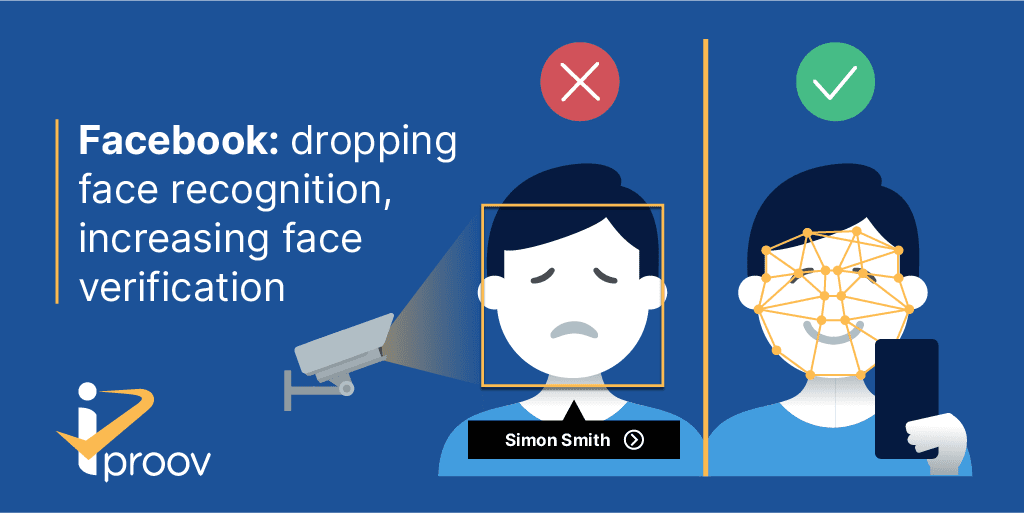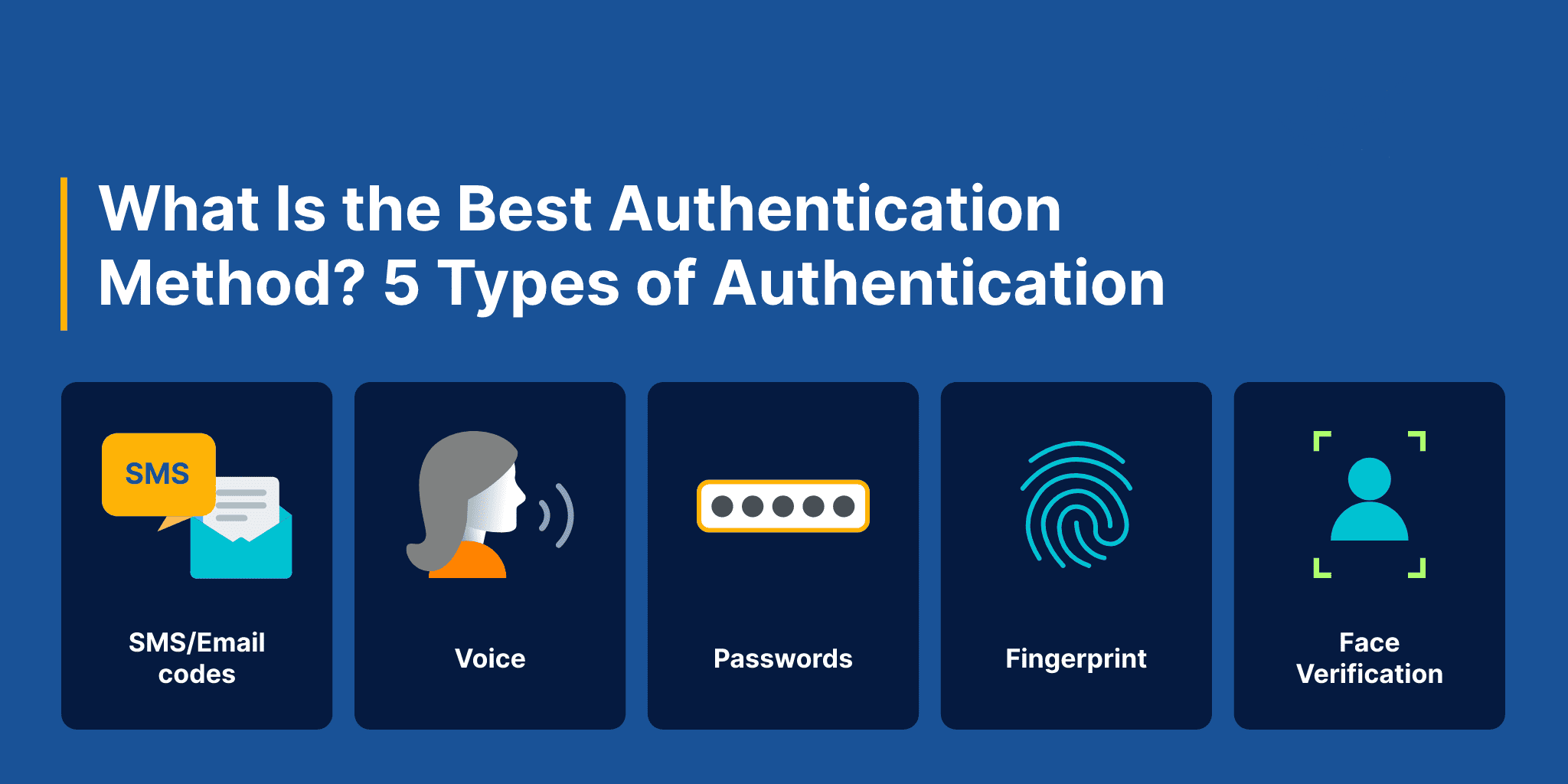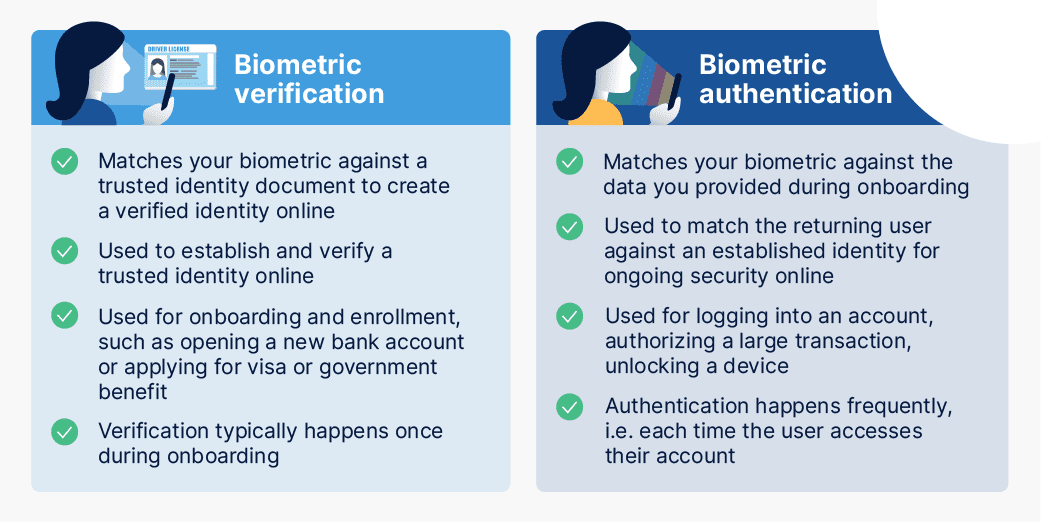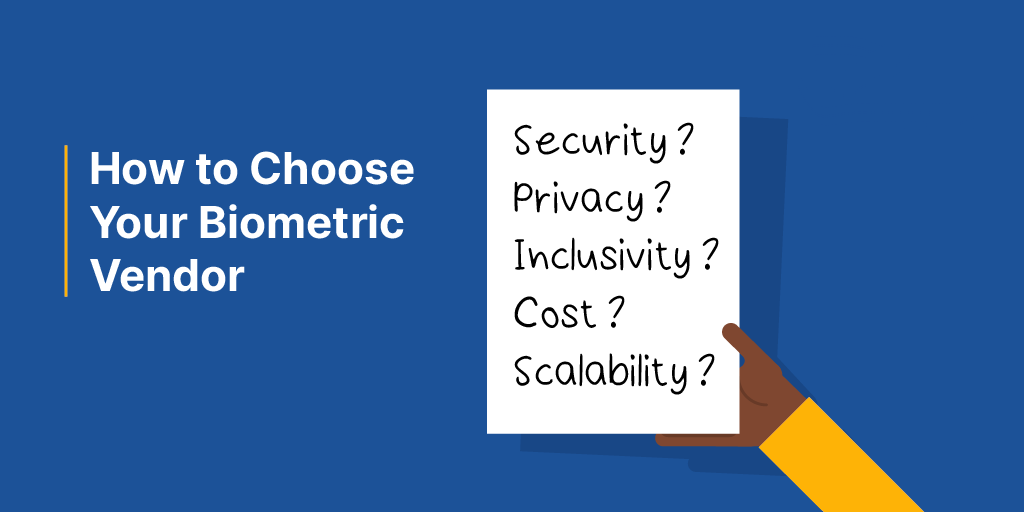November 8, 2021
Facebook is the latest organization to join iProov in drawing an important line between the use of biometrics for face verification versus face recognition.
In a press release, the company now known as Meta announced that it will no longer use face recognition to automatically recognize people’s faces on the Facebook platform.
But they also confirmed that the use of face biometrics for identity verification will grow in importance, seeing it as an important tool:
“Looking ahead, we still see facial recognition technology as a powerful tool, for example, for people needing to verify their identity, or to prevent fraud and impersonation.”
What’s the difference between face verification and face recognition?
Although Facebook refers to ‘face recognition’ in the above paragraph, they are describing face verification. So what’s the difference? Let us explain:
Face verification takes place when a user needs to verify their identity or authenticate themselves. For example, if you want to apply for a driver’s license or a credit card online, you need to be able to prove that you are who you claim to be and that you are not an imposter that is attempting to impersonate you. Then when you log back in to pay off your credit card bill, you will need to authenticate and prove that it is genuinely you that is accessing your account.
At the same time, online dating services like Tinder and social media networks are increasingly worried about users being defrauded by criminals using fake profiles of people that don’t exist at all. Face verification enables organizations to be certain that a user is the right person and a real person so they can protect their customers from fraud.
How does face verification work? With iProov, a user completes a brief, effortless face scan on a mobile device, computer or kiosk. The user knows it is taking place, they participate in the process, they get a direct benefit from it and their privacy is protected.
Face recognition is different. It often takes place when a user is unaware that it is happening—for example, a CCTV camera in a public place could be matching faces that it spots on the street with a database of criminals. The user is often not aware that it is happening, they don’t participate in the process or directly benefit from it, and their privacy is not protected in the same way that it is with iProov.
This is a useful summary:
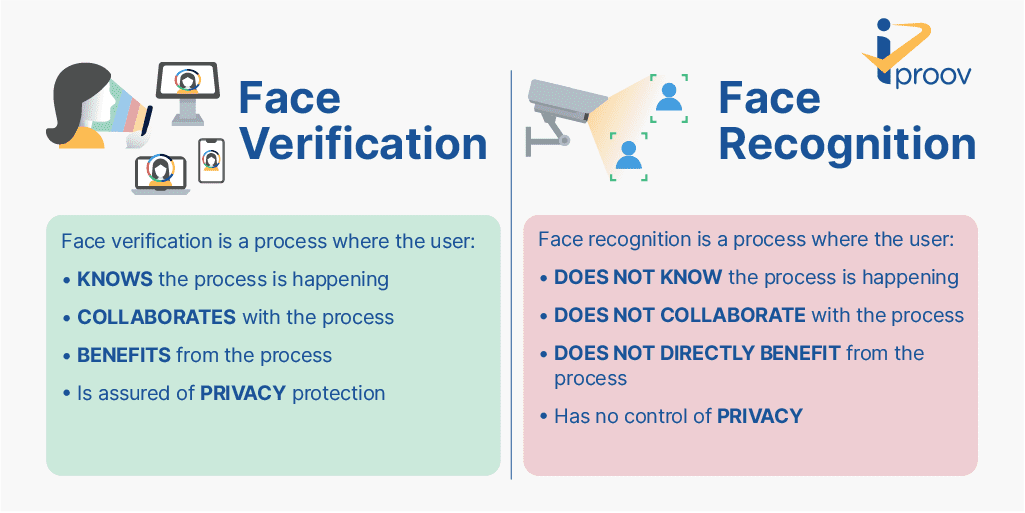
Why is Facebook shutting down its face recognition system and what does it mean for users?
Until now, Facebook would store a ‘faceprint’ of any user who opted in to the use of their face recognition system. This then enabled Facebook to identify that person if they appeared in any photos or videos that were uploaded to the platform. The user could then be alerted so they could tag themselves.
Facebook will no longer be providing this option to users and the faceprints of users that opted in will be deleted.
How will Facebook be using face verification from now?
Meta says that it will be looking at face verification for a number of use cases: “This includes services that help people gain access to a locked account, verify their identity in financial products or unlock a personal device. These are places where facial recognition is both broadly valuable to people and socially acceptable, when deployed with care.”
Why is the Facebook announcement so significant?
This announcement from Facebook demonstrates that:
- Society is recognizing the difference between face biometrics for enabling people to use the internet safely (face verification) and face biometrics as used in surveillance (face recognition). For too long, the two things have been lumped together and often seen in a negative light. That is rightly changing, as this announcement shows.
- Consumers appreciate the convenience of face verification and this is encouraging them to understand its benefits and the difference between verification and recognition. Earlier this year, iProov surveyed consumers in the UK, US, Canada, Australia, Spain and Italy and discovered that 38% already use face verification to access their mobile banking apps. A further 32% would do so if it was supported. Why? Convenience. Passive face verification, where the user has to do nothing but look at their device camera, is incredibly simple when compared to typing in passwords or tapping images with traffic lights in them.
- Facebook recognizes that face biometrics are a highly secure way to authenticate users online to keep them safe, and specifically calls out identity recovery and financial services as the areas where face verification will be most valuable. Face verification is more secure than passwords and other online security measures—Facebook appreciates this, as do other enterprises and government agencies around the world. As identity theft, money-laundering and other cybercrime increase, security will become ever-more imperative to protecting consumers and society as a whole.
How does iProov deliver face verification?
iProov’s face verification technology is being used by governments and enterprises around the world to verify the identity of users online.
Our Genuine Presence Assurance technology delivers the highest levels of security, usability, inclusivity, privacy and scalability:
- Security: iProov’s Genuine Presence Assurance is the only solution that verifies if an online user is the right person, a real person, and if they are authenticating right now. iProov is also cloud-based and does not depend on the integrity of the device as other solutions do. iProov customers also benefit from our iProov Security Operations Centre (iSOC)—we monitor attacks and adjust our algorithms to provide sustainable security in a way that other vendors cannot. This allows us to defend against evolving and unknown threats, including the use of deepfakes and digital injected attacks.
- Usability: iProov face verification is designed to be effortless for the user. There are no instructions to follow, such as moving the head or device or reading out words or numbers. The user simply positions their face in the oval on the device screen and the authentication completes.
- Inclusivity: Face verification is inclusive because everyone has a face and most devices have a user-facing camera. iProov’s solution is more inclusive than others because it requires no reading or following instructions and it can be used on any device with a user-facing camera—including mobile devices, computers, tablets, and kiosks—to make it available to the broadest community of users.
- Privacy: iProov uses a privacy firewall and strong encryption techniques to protect highly sensitive data such as face biometrics to safeguard the user’s confidentiality.
- Scalability: iProov technology is being used by governments, banks and other organizations around the world, including the UK Home Office, Australian Taxation Office and Singapore Government, to verify millions of online users.
Facebook and face recognition vs face verification: a summary
- Facebook has decided to end the use of its face recognition system. Users will no longer be automatically recognized in photos and videos, and facial biometric data will be deleted.
- The company will continue to use face biometrics for identity verification, for example for identity recovery, financial services and other scenarios where online security is needed.
- In doing this, Facebook joins the increasing number of organizations and individuals that recognize the difference between the use of face biometrics for online trust and the use of face biometrics for surveillance and other forms of recognition.
- It also demonstrates the acceptance of face verification as the most secure and convenient way to verify and authenticate online users.
- iProov’s Genuine Presence Assurance delivers the most secure, convenient, inclusive, scalable and private method for verifying and authenticating individuals online to prevent cybercrime.
- This is why iProov is the chosen vendor for organizations such as the US Department of Homeland Security, the UK’s National Health Service (NHS), the Australian Taxation Office, the Singapore Government and banks including Knab and Rabobank.
If you’d like to learn more about iProov’s face verification, please read about our Genuine Presence Assurance technology, read more about our case studies, or book an iProov demo here.
